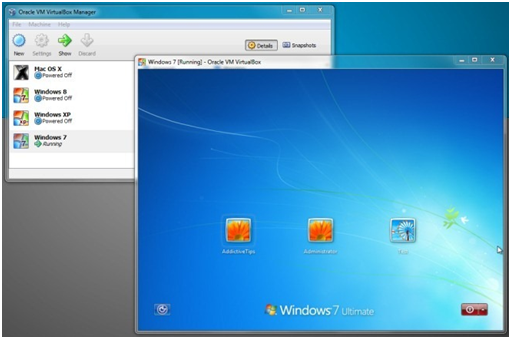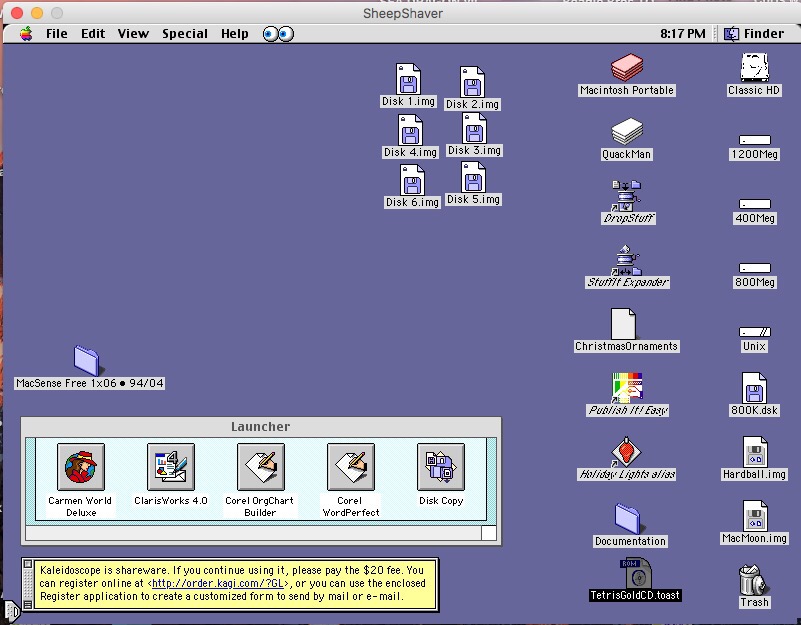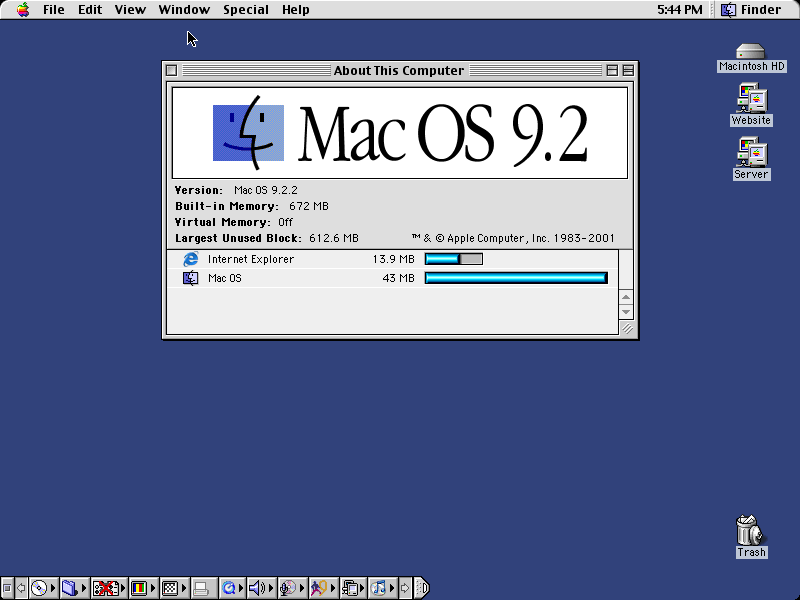

- Emulator mac os 9 how to#
- Emulator mac os 9 mac os x#
- Emulator mac os 9 install#
- Emulator mac os 9 plus#
The three supplied disk images are standard Mac OS X. Installing a larger disk image into Chubby Bunny turned out to be quite easy. The rest of this post concerns the resolution of these two issues.

The virtual screen size was limited to 1024×768 (I wanted 1280×1024) and the maximum disk image size you could use was limited to just 1.2 GB (a wee bit small for a well-stocked Mac OS 9 system in my opinion – I wanted something much larger). HOWEVER, I wasn’t entirely pleased with the configuration of Chubby Bunny. I was delighted to learn all of this, and wanted to pass it along to you, the readers of this blog.
Emulator mac os 9 how to#
That SHOULD be the end of this post – mission accomplished! I now know what the “Appleworks problem” is AND how to solve it, and as an added bonus, I have discovered how to run Mac OS 9 Classic on my modern iMac – Classic on Intel.
Emulator mac os 9 install#
There are only a small number of preconfigured applications in the Mac OS 9 instance you get this way, and oddly, given how this whole thing started, Appleworks is NOT one of them(!), but you can install more, just as you can with a real Mac OS 9 installation.
Emulator mac os 9 mac os x#
Here is a screen shot of Chubby Bunny running Mac OS 9.0.4 (Mac OS 9.0.4 is the highest version of Mac OS 9 supported by Sheepshaver) on my Mac OS X Mavericks 3.4 GHz 27” iMac (click the image to get the full size screenshot). That’s pretty much it! Launch Classic.app and Mac OS 9 pops up in all its glory. Installing Chubby Bunny is as simple as dropping its executable into your Applications folder (the application is called Classic.app, and it sports the “classic” Classic.app icon – a nice touch) and placing one of the three included disk images into your /Users/Shared folder. There are a LOT of curiously named applications in this post! 🙂 “Chubby Bunny” is a pre-configured version of Sheepshaver, with all of the setup already done. This is where another curiously named package came to the rescue. I won’t comment on the effort required to install and set up Basilisk II – I found the idea of an emulated PowerPC Mac far more attractive than the idea of an emulated 68K Mac. I looked into installing and setting up Sheepshaver on my Intel iMac and quickly found that the number of steps involved, and the amount of work involved in each step, was daunting to say the least. Sheepshaver emulates a PowerPC Macintosh Basilisk II emulates a 68K Macintosh. Sheepshaver is followed closely by the equally oddly named Basilisk II. The curiously named Sheepshaver application is the best supported Mac emulator currently out there. Installing and setting up either of the two major Mac OS emulators presently available is a bit of a chore. Sounds simple, right? Well, it turns out to be anything but simple. If you have an older Appleworks based document that you need to regain access to, how do you do this if you don’t have an older Mac to facilitate that access? The answer? Run a Mac OS 9 emulator on your modern Mac, install Appleworks into the emulator and then use it to recover full access to the document of interest. The “Appleworks problem” turned out to be fairly easily stated.

BlueStacks is one of THE MOST POPULAR emulators available today. This is a simulation of a Classic Macintosh from 1984, running System 7.0.1 with MacPaint, MacDraw, and Kid Pix.
Emulator mac os 9 plus#
PCE.js Mac Plus emulator running Mac OS System 7 - a hack by James Friend PCE.js emulates classic computers in the browser. What WAS “the Appleworks problem” and how DO you solve it? Following links in the comment, I stumbled upon an article about solutions to the “Appleworks problem”. Judicious shopping on places like eBay can produce a good deal on an older Mac.įor higher prices, but with better warranties and often recourse, some on-line sites offer used Macs.Recently, a reader of this blog submitted a comment regarding an earlier post. This Apple KBase article clarifies some of those -Īrticle #86209 - Some Computers Only Start Up in Mac OS X This Apple KBase article shows which machines and models are supported by Apple for OS 9 booting -Īrticle #25114 - Mac OS 8, 9: Compatibility With Macs These include those G4 MDD (Mirrored Drive Door) models whose processor speeds are 1.25GHz or slower, and which do not have a Firewire 800 port or any earlier G4 model.Īn iMac that is an original G4 model, or any G3 model.Īny iBook G3 model (none of the iBook G4 models are OS 9 bootable).Ī PowerBook G4 which is no newer than an '02 model.Īn eMac which did not come with a SuperDrive nor USB 2.0. If you need a machine which can boot to OS 9, you will need to get one of the following -Īn OS 9-bootable G4 tower. No G5 Mac can boot to OS 9, although they can use it as Classic. The Intel-processor Macs are not supported by Apple for OS 9 at all, either for booting or as Classic.


 0 kommentar(er)
0 kommentar(er)
